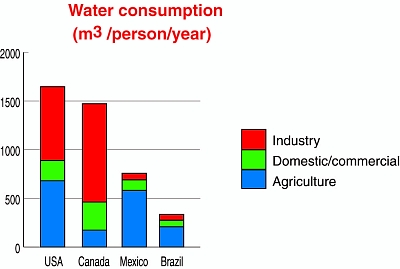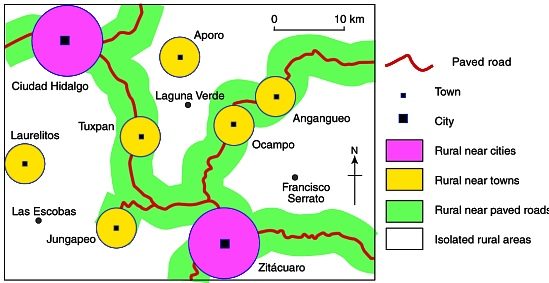In a previous post, we looked at why Some rural areas are more rural than others.This post describes each of the four distinct categories of rural areas identified by Mexico’s National Population Council (CONAPO).
Rural localities near cities
This group is defined as localities within five kilometers (3 mi) of cities of at least 15,000 inhabitants. It accounts for 16% of Mexico’s rural population, about four million people. About half of the rural populations of Morelos and Tlaxcala fall into this group.
Some communities in this category are actually part of the suburbanization or urban sprawl process. People have ready access to many city services and opportunities. If they lack mechanical transportation, they can walk to the city in less than an hour.
What are the socioeconomic characteristics of these localities? The data needed to answer this question often are not readily available. Fortunately, CONAPO has classified rural localities in terms of their degree of marginalization, which provides insights into socioeconomic characteristics. Degree of marginalization is defined using indicators of adult educational attainment, housing quality, and income levels.
About 47% of rural, near city residents live in very marginalized localities.3 While this is much higher than it is in urban areas, it is significantly less than other rural areas. Rural areas near cities tend to be more similar to urban areas. By way of comparison, in Mexico as a whole about 19% of the population live in municipalities classified as very marginalized.
Representative characteristics of very marginalized communities include adult populations with illiteracy rates of about 25% and completion of primary school rates of only 56%. Roughly 27% of houses lack piped water, 27% lack indoor toilets, 46% have dirt floors and 64% are overcrowded. These housing indicators are closely correlated with significant health risks. About 15% of houses do not have electricity. Roughly 84% of economically active people make less than twice the minimum wage. Communities matching this description are very different from modern urban Mexico.
At the other end of the spectrum, only about 4% of near city residents live in non-marginalized localities, which we will call “modern”.5 For Mexico as a whole, 53% of the population live in modern municipalities. The figure is 100% for the 33 million people who live in Mexico’s nine urban areas of over one million inhabitants. Levels of marginalization will be discussed more fully in chapter 29.
Rural localities near towns
This category includes localities within three kilometers of towns with between 2,500 and 15,000 residents. About 2.4 million people, or 10% of the rural population, live in such communities. These localities account for about a quarter of the rural population of Morelos and the State of Mexico.
Communities in this category are more rural than communities near cities. They have easy access to goods and opportunities in towns, but lack ready access to a real urban area. About 66% of this group lives in very marginalized communities compared to 47% for the near cities group. Less than 1% of the near towns group live in modern communities.
Rural localities near roads
This large group includes localities within three kilometers (2 mi) of paved roads. Almost 13 million Mexicans, about 54% of the rural population, fall into this category. It accounts for almost 90% of the rural population in Quintana Roo and over 70% in Zacatecas, Yucatán, Campeche, San Luis Potosí, Nuevo León and Coahuila.
This is a relatively important category because almost 14% of Mexico’s total population lives in rural communities near roads. These localities account for 39% of the total population of Zacatecas, and about a third of the total for Hidalgo, Oaxaca and San Luis Potosí. The authors agree to differ as to the reasons for this. One of us believes that the location of paved roads is having an impact on rural settlement patterns. The other believes that rural settlement patterns are having an impact on the location of paved roads! Both viewpoints may be correct with their relative importance depending on the region in question.
While people living in these localities do not have walking access to a city or town, they can relatively easily get to a town or city by bus. Some 69% live in very marginalized communities, while less than 1% live in modern communities. In terms of marginalization, the near roads group is quite similar to the near towns group.
Isolated rural localities
This group includes rural localities that do not fit into any of the other three categories. They are the most rural in that they lack ready access to paved roads, towns or cities. These inaccessible areas are very rarely seen by outsiders. Most urban residents have limited understanding of life in these isolated areas. Communities in this group are among Mexico’s poorest. About 88% of the people in isolated rural localities live in communities classified as very marginalized; less than 1% live in modern communities.
Though data are not available, areas that are within 10 km of a city, town or paved road are likely to be less marginalized than those in more remote locations. Almost five million Mexicans, about 20% of the rural population, live in these communities. Over a million people in Chiapas and about half a million in Oaxaca and Puebla live in isolated localities. The figure for Chiapas represents 29% of the state’s total population. About 16% of the people in Nayarit and Oaxaca and 12% of those in Sinaloa and Guerrero live in isolated areas. Providing needed basic services to these rural Mexicans is a major challenge for these state governments as well as the federal government.
Related posts:

